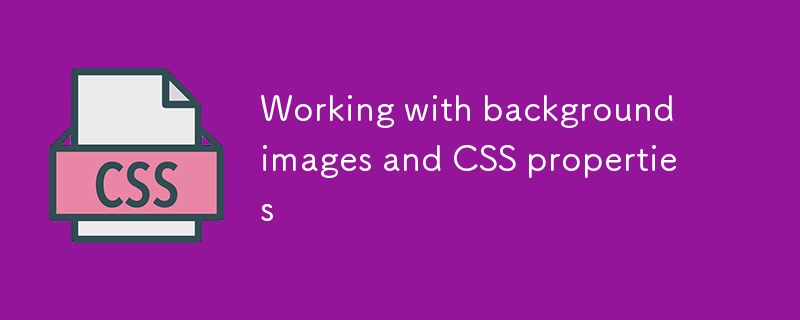Found a total of 10000 related content

Implementing Native Lazy Loading for HTML5 Images and Iframes
Article Introduction:How to implement lazy loading of images and iframes in HTML5? By adding loading="lazy" attribute to the and tags, the browser delays loading these elements until they are about to enter the viewport. Applicable scenarios include non-first-screen content at the bottom of the page, gallery or product pages with a large number of pictures, content skipped by mobile terminals in responsive design, and pages with multiple iframes embedded. It is not recommended to use lazy loading for key content on the home screen such as logo or banner. Notes include: 1. When it is compatible with old browsers, you must introduce polyfill; 2. Ensure that the search engine can recognize the image content to avoid SEO influence; 3. Set placeholders to prevent layout jitter; 4. Dynamically inserted pictures need to be manually processed and lazy loaded.
2025-07-07
comment 0
395

How to optimize video loading speed in HTML5? How to adapt HTML5 videos to mobile?
Article Introduction:Methods to optimize HTML5 video loading speed: Use modern video codecs (such as VP9, ??H.265) to compress files. Implement an adaptive bitrate video stream to adjust video quality. Download videos in chunks to download in parallel. The video is delayed and does not start loading until the user scrolls. How to adapt HTML5 video on mobile: Ensure that the video codec is compatible with the device. Resize the video container to fit the screen. Select a lower bit rate to reduce buffering. Use responsive design techniques to adjust the layout. Optimize video controls and players to suit touch screen devices.
2025-04-06
comment 0
446

Implementing lazy loading images with HTML5 loading attribute
Article Introduction:The method to use loading="lazy" to achieve lazy loading is to add this attribute to the tag, which is natively handled by the browser; its advantages include reducing the initial load of the page, improving performance, and being more conducive to SEO and barrier-free access; when using it, you should avoid lazy loading of the first-screen image. It is recommended to use placeholders to prevent layout jitter, ensure the correct image format, and pay attention to the compatibility of third-party components.
2025-07-05
comment 0
146

HTML5 Web Audio API Tutorial: Building a Virtual Synth Pad
Article Introduction:This article explores the HTML5 Web Audio API, demonstrating how to build a basic virtual synth pad with various audio effects. We'll cover creating an AudioContext, loading and playing audio files, adding volume control, looping, reverb, and filter
2025-02-21
comment 0
1138

Why Is My SVG Animation Invisible in IE11?
Article Introduction:IE11 SVG Animation DiscrepancyDespite having a flawless SVG loading animation in Firefox and Chrome, users are encountering issues in IE11 where...
2024-12-08
comment 0
988

How to Build Your Own Progressive Image Loader
Article Introduction:Progressive Image Loading: A Smooth, Efficient Approach to Image Display
This article explores progressive image loading, a technique enhancing user experience by prioritizing speed and visual appeal. It utilizes HTML5, CSS3, and JavaScript to deliv
2025-02-17
comment 0
261

Loading and manipulating images with HTML5 Canvas.
Article Introduction:Loading the image to HTML5Canvas requires waiting for the image to load. You can perform drawing operations through the img.onload callback; use the drawImage method to draw a complete image, scale the image or capture a partial image; after drawing, you can use getImageData to obtain pixel data and write back the modified content with putImageData. The specific steps are: 1. Create Image object and set src; 2. Call drawImage in the onload callback to draw the image; 3. Use different parameters of drawImage to achieve image drawing, scaling and cropping; 4. Get the pixel array through getImageData for processing; 5. Use putImag after the processing is completed
2025-07-04
comment 0
701

How to optimize images for web
Article Introduction:The core of optimizing images for web pages is to balance quality and loading speed. The key steps include: 1. Select a suitable format such as JPEG, PNG, WebP and SVG; 2. Control the size and resolution and crop according to the display area; 3. Use lossy or lossless compression to reduce volume; 4. Apply lazy loading and responsive image technology to improve loading efficiency.
2025-06-30
comment 0
555

HTML5: The Building Blocks of the Modern Web (H5)
Article Introduction:HTML5 is the latest version of the Hypertext Markup Language, standardized by W3C. HTML5 introduces new semantic tags, multimedia support and form enhancements, improving web structure, user experience and SEO effects. HTML5 introduces new semantic tags, such as, ,, etc., to make the web page structure clearer and the SEO effect better. HTML5 supports multimedia elements and no third-party plug-ins are required, improving user experience and loading speed. HTML5 enhances form functions and introduces new input types such as, etc., which improves user experience and form verification efficiency.
2025-04-21
comment 0
1033

Optimizing Performance of HTML5 Web Applications
Article Introduction:The core methods to improve HTML5 Web application performance include: 1. Reduce loading time, compress resources, merge files, enable cache, use CDN and delay loading of non-critical resources; 2. Optimize JavaScript execution efficiency, avoid long tasks, reduce DOM operations, use anti-shake and throttling, and load code on demand; 3. Optimize pictures and multimedia, adopt appropriate formats, responsive pictures, delay loading and control animation frame rate; 4. Use modern APIs such as ServiceWorkers, IntersectionObserver, requestAnimationFrame and WebComponents to improve performance. These strategies can effectively improve the loading speed of applications
2025-07-04
comment 0
849

Working with background images and CSS properties
Article Introduction:How to set web page background image with CSS and optimize loading? First, select the appropriate background image, select JPG/WebP/PNG format according to the purpose, and pay attention to copyright in a unified style; second, use CSS attributes to set the background image, including background-image specified path, background-repeat control duplication, background-size and background-position adaptation to the screen; third, optimize the loading speed, improve the user experience by compressing images, using WebP format, delaying loading, adding transition effects and setting transition colors.
2025-07-11
comment 0
847

Canvas vs SVG: Choosing the Right Tool for the Job
Article Introduction:HTML5 Canvas vs. SVG: Which one to choose?
HTML5 Canvas and SVG are both based on standard HTML5 technologies that can be used to create stunning graphics and visual effects. This article discusses a key question: Which technology is more suitable to choose in the project? In other words, in what cases are you more inclined to use HTML5 Canvas than SVG?
First, let's briefly introduce HTML5 Canvas and SVG.
Key Points
HTML5 Canvas and SVG are both HTML5 technologies used to create graphical and visual experiences. Canvas relies on resolution and is used to dynamically render graphics, game graphics, artworks, or other visual images. SV
2025-02-10
comment 0
464

What are the different ways to handle side effects in Vue.js components?
Article Introduction:The article discusses managing side effects in Vue.js, focusing on lifecycle hooks, watchers, computed properties, methods, and the Composition API. It also covers asynchronous operations using promises, loading states, error handling, and tools like
2025-03-31
comment 0
344

What are the successful cases of H5 page production
Article Introduction:The key tips for successful H5 page production cases are carefully arranged to ensure smooth and natural. Cleverly utilize touch screen events to realize user interaction. Adopt lazy loading technology to improve page loading speed. Pay attention to user experience and avoid blindly pursuing cool effects. Focus on performance optimization and code maintainability. Comprehensive testing to ensure proper use on all browsers and devices.
2025-04-06
comment 0
290













